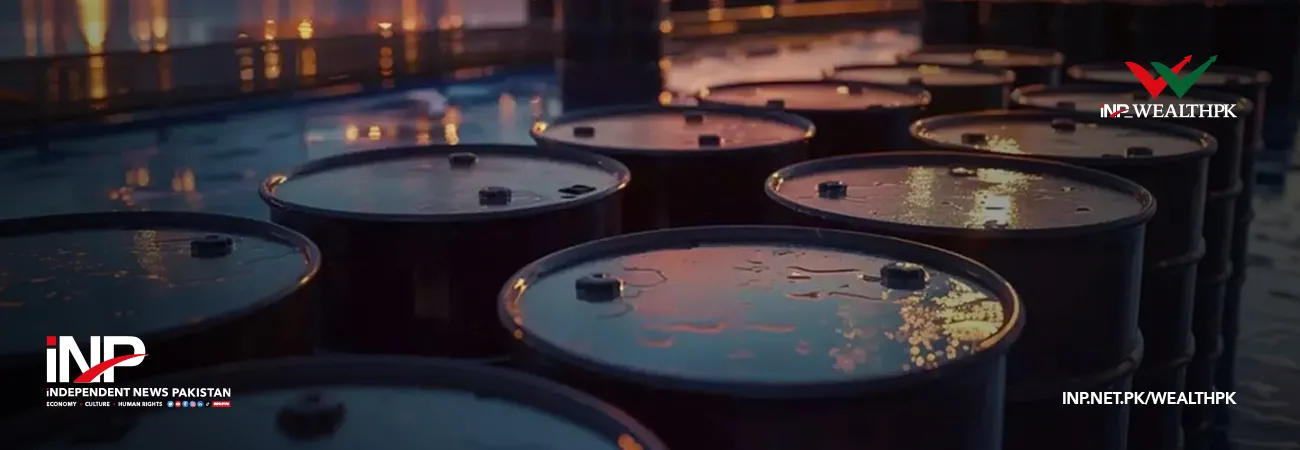آئی این پی ویلتھ پی کے
By Qudsia Bano
Pakistan’s crude oil production has declined by a quarter over the past decade despite modest yearly gains, with remaining reserves now sufficient for less than ten years of supply at the current rate of extraction. In fiscal year 2023-24, the country’s crude oil production inched up by 2 percent compared to the previous year due to limited new discoveries and improved recovery from mature fields, but overall output remains constrained, reflecting weak exploration activity and low investment in the upstream sector.

According to the Pakistan Energy Market Review 2025 by Renewables First, Pakistan’s total proved and probable reserves, known as 2P reserves, stood at 1,304 million barrels by the end of FY24, a 6 percent increase from 1,229 million barrels recorded the previous year. The increase was mainly attributed to new exploration work that marginally expanded the reserve base in Sindh and Khyber Pakhtunkhwa. Sindh continued to dominate the country’s oil resource portfolio, holding 44 percent of total reserves, followed by Punjab with 35 percent and Khyber Pakhtunkhwa with 16 percent.
The report said cumulative production reached 81 percent of total 2P reserves by June 2024, underlining the progressive depletion of Pakistan’s mature oil fields. The reserves-to-production ratio, a key indicator of sustainability, improved slightly to 9.4 years in FY24 from 7.6 years a year earlier, primarily because of slower output rather than significant new reserves. This ratio means that if no major new discoveries are made, Pakistan’s current oil reserves would be exhausted within a decade.
Pakistan’s crude oil production during FY24 averaged around 70,000 to 71,000 barrels per day, translating to approximately 3.5 million tonnes of oil equivalent (Mtoe). The modest year-on-year rise was achieved through incremental efficiency improvements at existing fields and small new finds. However, production remains far below the levels recorded in FY15 when daily output exceeded 94,000 barrels. The steep long-term decline highlights structural weaknesses in the country’s upstream petroleum sector, which continues to face low investor confidence, foreign exchange constraints, and slow regulatory processes.
The report observed that limited exploration activity and the natural depletion of aging reservoirs have prevented meaningful recovery in domestic output. Several key fields, especially in southern Sindh and central Punjab, have matured beyond their production peak. Foreign companies operating in Pakistan’s upstream segment have also reduced activity in recent years due to delays in licensing, security concerns, and the unattractive returns offered under existing fiscal terms.
At the same time, crude oil imports have declined for the second consecutive year, reflecting lower demand from refineries and reduced consumption of petroleum products. Pakistan imported 8.5 Mtoe of crude in FY24, down from 11.7 Mtoe in FY22, marking a 24 percent reduction over two years. Imports of petroleum products also contracted by 18 percent year-on-year to 7.1 Mtoe. The contraction in crude and product imports eased some pressure on the external account but was mainly the result of weaker economic activity and affordability issues rather than domestic substitution.
Pakistan’s refinery throughput increased by 11 percent in FY24 compared to the previous year, processing a total of 12 Mtoe of crude oil, with 71 percent of the feedstock sourced from imports and 29 percent from local production. Refinery output was dominated by high-speed diesel, furnace oil, and motor spirit, which together accounted for 85 percent of production, indicating the continued dominance of transport-driven demand and limited progress toward value-added downstream diversification.
Despite a temporary rebound in refinery utilization, the country’s refining sector remains under stress due to outdated technology, thin margins, and a lack of investment in upgrading capacity. Policymakers have discussed refining policy reforms and new projects such as deep conversion units, but few have materialized so far. The report underscored that the short-term production rise cannot offset the broader structural decline in the sector, which threatens long-term energy security and increases Pakistan’s dependence on imported fuels.
The depletion of crude reserves and continued reliance on imports expose the economy to external shocks, exchange-rate volatility, and global price fluctuations. The decline in domestic production also narrows the scope for future energy self-sufficiency and undermines government efforts to improve the balance of payments. Renewables First emphasized that strengthening exploration incentives, modernizing the policy framework, and ensuring transparent licensing are crucial to attracting new investment and reviving the upstream segment.
The report concluded that unless new reserves are discovered and production efficiency is substantially improved, Pakistan’s crude oil base will continue to shrink, deepening the country’s dependence on imported energy. It warned that the marginal output gains of FY24 represent a temporary stabilization rather than a sustainable recovery. The continuing depletion of mature fields, weak exploration, and limited capital inflows remain the main risks to the country’s long-term energy balance.
According to the Pakistan Energy Market Review 2025 by Renewables First, reversing the production decline will require urgent reforms, including rationalized fiscal incentives, technological upgrades, and a consistent policy regime capable of attracting global exploration partners to revive Pakistan’s oil sector.
Credit: INP-WealthPk











